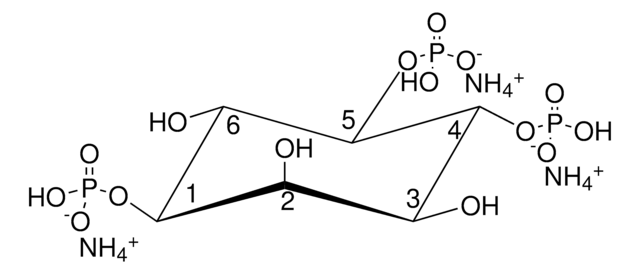850151P
Avanti
18:1 PI(4)P
Avanti Research™ - A Croda Brand 850151P, powder
Synonyme(s) :
1,2-dioleoyl-sn-glycero-3-phospho-(1′-myo-inositol-4′-phosphate) (ammonium salt)
About This Item
Produits recommandés
Essai
>99% (TLC)
Forme
powder
Conditionnement
pkg of 1 × 100 μg (with stopper and crimp cap (850151P-100ug))
pkg of 1 × 500 μg (with stopper and crimp cap (850151P-500ug))
Fabricant/nom de marque
Avanti Research™ - A Croda Brand 850151P
Type de lipide
cardiolipins
phospholipids
Conditions d'expédition
dry ice
Température de stockage
−20°C
Chaîne SMILES
[H][C@@](COP([O-])(O[C@H]1[C@H](O)[C@@H](O)[C@H](OP([O-])(O)=O)[C@@H](O)[C@H]1O)=O)(OC(CCCCCCC/C=C\CCCCCCCC)=O)COC(CCCCCCC/C=C\CCCCCCCC)=O.[NH4+].[NH4+]
Description générale
Application
Actions biochimiques/physiologiques
Conditionnement
Informations légales
Souvent commandé avec ce produit
Code de la classe de stockage
11 - Combustible Solids
Classe de danger pour l'eau (WGK)
WGK 3
Point d'éclair (°F)
No data available
Point d'éclair (°C)
No data available
Faites votre choix parmi les versions les plus récentes :
Certificats d'analyse (COA)
Désolés, nous n'avons pas de COA pour ce produit disponible en ligne pour le moment.
Si vous avez besoin d'assistance, veuillez contacter Service Clients
Déjà en possession de ce produit ?
Retrouvez la documentation relative aux produits que vous avez récemment achetés dans la Bibliothèque de documents.
Les clients ont également consulté
Notre équipe de scientifiques dispose d'une expérience dans tous les secteurs de la recherche, notamment en sciences de la vie, science des matériaux, synthèse chimique, chromatographie, analyse et dans de nombreux autres domaines..
Contacter notre Service technique














